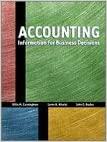Ava Mendleson operates a small fabric shop. She has been earning a satisfactory profit but is short
Question:
Ava Mendleson operates a small fabric shop. She has been earning a satisfactory profit but is short of cash. Following is an accurate but unclassified balance sheet of the store on December 31, 1999.

On January 2, 2000, Ava went to her bank to get a loan for her company. The bank agreed to loan her $5,000 under the following conditions. First, the note payable would be a three-year note, so that the company would repay $5,000 plus $1,500 interest on December 31, 2002. Second, she must prepare a “forecasted” classified income statement for 2000 that shows that the company expects to earn a net income of at least $11,000 and that it will have “satisfactory” profit margin and return ratios. Third, she must prepare a “forecasted” cash flow statement for 2000 that shows that the company expects to have cash on hand at the end of 2000 of at least $10,000 (including the cash from the bank loan) and that it will have “satisfactory” operating cash flow ratios. Finally, she must prepare a “forecasted” classified balance sheet as of December 31, 2000 that shows a current ratio of at least 3.0 and a debt ratio of no more than 40%.
Ava has never prepared any forecasted financial statements. She understands, however, that they are prepared using the best estimates she can make, based on the store’s previous operations and her future expectations. Ava has come to you for help, having gathered the following information:
(a) Sales for 2000 are expected to be $80,000. Of these, half will be cash sales, and half will be credit sales. There are no cash discounts. Of the credit sales, 10% will not be collected until 2001. The accounts receivable on December 31, 1999 will be collected in 2000.
(b) Purchases of inventory for 2000 are expected to be $50,000. All purchases are on credit; there are no cash discounts. Of the purchases, |2% will not be paid until 2002. The accounts payable on December 31, 1999 will be paid in 2000.
(c) Sales returns and purchases returns are expected to be insignificant.
(d) The company’s gross profit percentage has been 40% of sales, and this rate is expected in 2000.
(e) The store rents space in a local mall. The rent is $200 per month; the rent for the whole year is due on January 6, 2000.
(f) |The store equipment that originally cost $8,000 has a 10-year estimated life, after which it is expected to have no value.
(g) | Ava pays her one salesperson a basic salary of $7,000 per year, plus 10% of gross sales. The total salary for 2000 will be paid in cash by the end of the year.
(h) Ava expects to withdraw $8,000 during 2000 to cover her personal living expenses.
(i) Other operating expenses are expected to be $1,600 in 2000; these will be paid in cash by the end of the year.
You determine that the information Ava has gathered is “reasonable” and includes her best estimates.
Required: (1) Prepare a forecasted classified income statement for 2000. Show supporting calculations.
(2) Prepare a forecasted cash flow statement for 2000. Show supporting calculations.
(3) Prepare a forecasted classified balance sheet as of December 31, 2000.
Show supporting calculations.
(4) Compute the applicable ratios and briefly discuss whether the company has met the bank’s conditions. plo47
Step by Step Answer:

Accounting Information For Business Decisions
ISBN: 9780030224294
1st Edition
Authors: Billie Cunningham, Loren A. Nikolai, John Bazley





